Our rental on the French Polynesian island of Moorea included a mostly outdoor kitchen and not only divine views overlooking Cook's Bay but also the mostly welcome comings and goings of the owners' two dogs who felt right at home by our unit!
We never grew tired of waking up to these unforgettable views.
This cruise ship had arrived in the harbor overnight and stayed out for two days.
With the luxury and freedom of having the rental car at our disposal, we jumped in it to explore another beach that our property owner had recommended we see.
Just beyond Cook's Bay was Opuno'hu Bay where the white-sand Ta'ahiaman'u Beach was located. If you were to describe a dream beach, you'd be hard-pressed to come up with one any lovelier than this one. Since there was no tide and there was crystal-clear water, it was perfect for swimming as well as snorkeling just a few yards from the shore with warm water just teeming with fish. IF that wasn't enough, it had gorgeous mountain views and lots of sailboats to make a picture-perfect day.
Steven and I had to be extremely careful where we sat on the beach, though, so we didn't get beaned by one of the coconuts that were falling. The palm trees on the beach were definitely a mixed bag as they were not only beautiful and provided welcome shade but unwelcome coconuts that we never knew when they might fall!
Liesbet: I wonder if you and Mark moored your sailing boat here in the bay when you visited Moorea? If so, you likely would have been in good company based on all the boats we spotted.
Quite a few people seemed to prefer the park further inland from the beach as it was perfect for picnics but the chances were still high one could get hit by a falling coconut.
Across the street from the beach was a large paved car park that had changing rooms and normally a food truck, we noticed, as we returned to the beach several more times.
I don't think I've ever seen a hairbow on a bathroom sign before. This was so cute!
Driving back to our rental I was glad I was the passenger and could just take in one more beautiful view after another as we drove around the bays.
The wooden Chapelle St. Joseph on Cook's Bay was one of two Catholic churches on the island. Built in 1873, it was renovated in 1963. Like all but a couple of churches we tried to enter while touring French Polynesia, this one was also closed unfortunately.
A much newer Protestant church was next door.
Later that afternoon, we drove halfway around the island to the village of Haapiti to the Tiki Village Cultural Center on the recommendation of Cathy, aka Catherine, our rental's French co-owner. Steven and I had reserved tickets for the dinner and music show that had been operating since 1986.
The paved roads on the other islands were generally of inferior quality compared to those in Canada and the US. What a joy to drive and be a passenger on Moorea as the roads were what we were used to!
The entrance tickets to the Tiki Village Cultural Center included a tour of a recreated Tahitian village, a buffet dinner followed by a Polynesian music and dance show with 32 dancers and other staff members who live year-round in the village.
Since we'd arrived early, we just wandered around the village at our leisure.
I read that a 'royal' Tahitian wedding could be arranged in the village with the bridegroom arriving by canoe and the newlyweds then carried around in a procession by four 'warriors.' It's important to note the weddings aren't legally binding. though.
We didn't 'get' why there were so many dinosaur recreations in the village as we didn't understand the connection between dinosaurs and Polynesians.
Tattoo 101: After already spending close to three weeks in French Polynesia, Steven and I had seen a huge, huge number of local men and women sporting elaborate tattoos. That was why I was curious reading at the village that the revival of Polynesian tattoo art had mostly happened among the younger generation who wanted to focus on traditional and cultural values. They considered tattoos as evidence of a renewal of their Polynesian identity.
The legend of the origins of Polynesian tattoos: Tattoo was created by two gods, the sons of the god Ta'aroa, according to Polynesian legend. They were members of a group devoted to arts and crafts, among whom were the God of Skill and the Daughter of the First Man. When two gods fell in love with the young woman, they invented the art of tattooing and adorned their bodies with different patterns. She was so delighted and 'succumbed' to the art of tattooing. Gods transmitted the art to people as they believed it was an interesting practice.
I had never much thought about the origins of the word 'tattoo' but should have realized after the village's extensive exhibit that it came from the Polynesian islands in Oceania. In Tahiti, tatau means 'to hit' and comes from a Polynesian expression Ta-Atua, a combination of Ta meaning 'drawing under the skin' and Atua meaning the spirit.
No one knows exactly the history of tattoo or tatau even though it was an ancestral tradition. It is believed that it was brought by migrants from Southeast Asia who settled in the Eastern Polynesian islands around the 2nd century BC. Soon after the discovery of Polynesia by Christian missionaries in 1797, tattoos were banned as they were considered a 'barbarous practice' because the techniques of the time included using sharks' teeth or sharpened bones to tattoo. Polynesian tatau was at the center of debates among French religious authorities until the beginning of the 20th century because of tattoos' divine connotation and because tattooing was thought to be "a deviant tradition of mutilation." That was why the art of tattooing disappeared for more than 150 years. Thanks to notes and sketches from a German missionary, Karl von Steinem, who drew more than 400 examples, the art of tattooing was rediscovered.
Marquesan motifs are mostly represented in French Polynesia because they mostly resemble Tahitian motifs. The revival of tattoo art and its resurgence in the South Pacific islands go back to the 1980s, partly as a result of competitions during the Tiurai Festival organized by tattoo artists in the Samoan archipelago, a state independent from Polynesia. The preservation of Polynesian traditions started then to be an important issue like dances, arts and crafts, stone lifting contests, javelin throwing contests, etc.
I read that in the Polynesian culture, tattoos represented strength, power, and wealth. That was why a man with a lot of tattoos had a tremendous amount of social prestige. Tattoos represented a very precise territory with membership in a clan, to a family, and to a social rank. They also signified social rituals like puberty and weddings, as well as deeds achieved by the tattooed person such as bravery during wars, hunting or fishing feats, etc. By contrast, a person with no tattoos was despised.
Males started to get tattoos at the age of 11 and 12 and finished by the age of 30 when some men had tattoos all over their bodies. Only warriors or priests had facial tattoos, on their foreheads or lips.
Men and women had different tattoos; the latter were confined to their hands, arms, feet, and lips. Important women like chiefs' wives were able to get tattoos on their thighs and buttocks. In order to have tattoos before puberty, girls were tattooed around the age of 8. As the goal of women's tattoos was seduction, they were more ornamental, more elegant, and better drawn.
Another reason people got tattooed was there was no writing in Polynesian culture. As a result, tattoos expressed a person's identity and personality as well as his/her genealogy, social rank, and sexual maturity. Tattoos were valued by Polynesian tribes because the young adult was identified within the community from the motifs that represented him/her. The tattoos evolved with the person's life.
I found it interesting to learn that tattoos also had a sacred aspect in Polynesian culture as they protected men against the loss of Mana or purity and assured they would be "healthy, fit, and fertile." As the tattoos were permanent on their bodies, they became reliable proof of their origin, social ranking, and achievements to show the gods when they would appear before them.
We luckily hadn't missed a stunning Polynesian sunset with our thorough examination of the engrossing tattoo exhibit.
I think this is my all-time favorite photo of us and it took just one second and a gorgeous backdrop, mind you, to get it!
In French Polynesia, Santa Claus is known as Pere Noel which meant Father Christmas.
More of the dinosaur theme throughout the village:
One of the buildings in the village was devoted to French artist Paul Gauguin who left for Tahiti in 1891 at the age of 43. The island had recently been colonized by France. There, he looked toward the islanders for new sources of inspiration. After only a few months, however, he returned to Europe disappointed.
Just two years later, though, Gauguin sailed to the Marquesas Islands, even further away from Western civilization. He was described as "behaving like a plain colonist, revengeful with regard to the administration, scornful of the natives, carried on alcohol, and weaned on juvenile flesh."
His paintings and sculptures were also described as representing "the sad love and the empty eyes of the natives" as "he translated the anguish of a Western culture in crisis." When Gauguin died "in misery" in the Marquesas in 1903, two years after his second arrival in the South Pacific, he was the precursor of the Art Nouveau style.
This was the exterior of the village's recreated Gaugin House. The artist referred to the original as his Pleasure House, no doubt because the middle-aged Gauguin entertained and cavorted with young teenage girls there!
A large exhibit was also devoted to American actor and director Marlon Brando, 1924-2004, who came to French Polynesia in 1960 for the filming of The Mutiny on the Bounty. At age 36, the twice divorced Brando married his 19-year-old Tahitian love interest and they bought an atoll near one of the larger islands. He said he discovered in Tahiti a country and a people that showed him a new vision of life and happiness. He wrote in his autobiography, "I owe Tahiti the best time of my life. If I ever came close to real peacefulness, it was on my island among the Tahitian people. when I arrived there, I stupidly thought I could help them with my money; on the contrary, I realized that they didn't need anything more than they had, and they had a lot to share with me."
Per his will, some of his ashes were scattered in California's Death Valley and the rest in the lagoon around his atoll .
From our initial arrival on the island of Huahine about two weeks previously, Steven and I kept hearing the two-syllable Polynesian word fare. We had known it meant 'house' but learned that night it also meant 'the place where you are protected.'
The emcee then showed all the guests the Polynesian underground oven or tamaaraa. Our dinner had been cooking all day long on volcanic stones until they reached a 200 degree temperature. The rocks had lots of small holes in them so heated up well. The food was then placed atop the rocks with banana leaves on top of them. Finally, a coconut fiber mat was placed on top.
The only other time Steven and I had eaten food that had been cooked underground had been in the Wadi Rum Desert of southern Jordan. Janina: There's one more reason you and Pat should go there!
After the 'unveiling' of all the layers, we finally could see the cooked food! Enough had been cooked for each of the participants to only have a small amount to taste as the rest of our dinner had been prepared in a conventional oven.
The fellow told us that after he'd found the lovely conch shell in 20 meters of water, he cleaned out the innards and cut the end so he could blow into it. The sound was loud!
The emcee pointed out that the drum was made out of cow skin now. In the past, it was made of whale skin until that was banned.
Flutes were originally made of bamboo instead of wood. The emcee, who was really a jack of all trades we found out, played the flute with his nose, not his mouth as we'd always seen in the past. He mentioned that was a 'purer way' of playing because it came from the spirit.
I need to improve my selfie-taking skills as Santa Claus and his sleigh in the background was blurry.
We felt that the buffet dinner was more about quantity and appearance than quality but that seems the norm for dinner shows in our admittedly limited experience.
During dinner we were treated to the 101 ways men and women could wear the pareo - I'm exaggerating, I know, but not by much! The pareo was developed in Tahiti and adapted to Western fabric when it was introduced by European explorers in the 1700s. A pareo is a rectangular piece of fabric that is wrapped and tied to create different clothing pieces. Pareos are worn by men and women in tropical South Pacific countries. The pareo is traditional wear that was first created from cloth made of bark and leaves. The same type or garment is known as a sarong in Hawaii but the names are often interchangeable.
Ancient Tahitian patterns are often floral, and the colors are either bright or have a watercolor effect. To achieve the popular rainbow watercolor look used for many pareos, Polynesians use Hawaiian rock salt over dyes or paints.
From our experience with our guide on Bora Bora, we knew that Polynesian men wear the pareo as a waist wrap. There are 30 or more ways for women to tie and wrap pareos. For instance, the neckline variations include halter, straight, drop, and one shoulder styles. Within these necklines, the options increase further since a halter neck may feature a wider soft tie at the corners of a pareo, or thinner tying pieces may be made by twisting the fabric in a tight, rope-like way. Pareos tied on one shoulder were one of the first dress styles to become popular in French Polynesia.
By the end of dinner, I had a newfound appreciation for the art of pareo wearing, let me tell you!
We then returned to the small stadium for the post-dinner show which was extremely entertaining from beginning to end with rapid-fire costume and hair changes as well as song and dance numbers. I'll let the pictures tell the tale.
At the very end, the audience was thanked for enjoying the Cultural Center and was wished good health and a continued happy vacation in French Polynesia. How could we not with the spellbinding performance we'd just witnessed!
Next post: A boat ride over to the private Cocoa Beach followed by a drive around the entire island.
Posted on February 2nd, 2022, from Phoenix, Arizona, where we've come for the entire month to get away from Denver's snow and much chillier weather. This is the first year we decided to escape for a chunk of Denver's winter for this long a period. I think we can already see as becoming habit-forming!

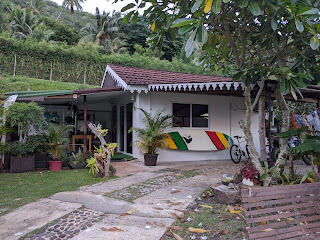

















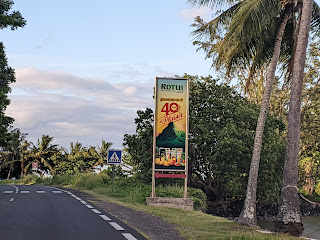







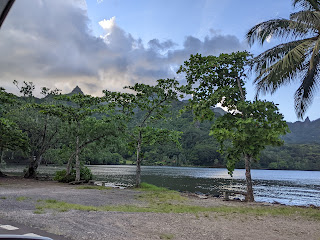




























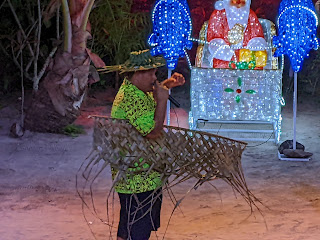






















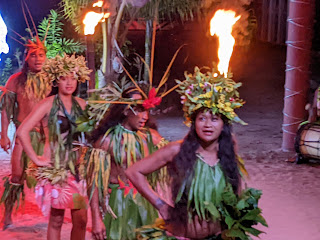

















What a terrific evening performance, what a FABULOUS photo of you two and what a fascinating and informative narrative on pareos and tattoos. MERCI ! xo
ReplyDeleteLina,
DeleteThanks for all the kudos - you are going to make my head swell!
I want to cruise on that ship at the beginning of blog. Tattoos are also very important in New Zealand. And cooking food in a pit is also found in Chile. You had a wonderful day!!! Janina
ReplyDeleteJanina,
DeleteI wouldn't mind sailing the seas of the South Pacific in that ship either! I remember the Kiwis sporting lots of tattoos but hadn't known their history before our night at the Tiki Cultural Center. Cooking food in a pit in Chile was news to me even though we've traveled there. Thanks for reading the post!